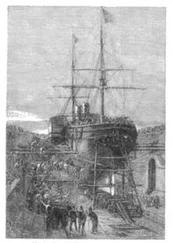“Captain Nemo,” I said, “I’ll vouch for the results and not try to explain them. I’ve seen the Nautilus at work out in front of the Abraham Lincoln, and I know where I stand on its speed. But it isn’t enough just to move, we have to see where we’re going! We must be able to steer right or left, up or down! How do you reach the lower depths, where you meet an increasing resistance that’s assessed in hundreds of atmospheres? How do you rise back to the surface of the ocean? Finally, how do you keep your ship at whatever level suits you? Am I indiscreet in asking you all these things?”
“Not at all, professor,” the captain answered me after a slight hesitation, “since you’ll never leave this underwater boat. Come into the lounge. It’s actually our work room, and there you’ll learn the full story about the Nautilus!”
Table of Contents
A MOMENT LATER we were seated on a couch in the lounge, cigars between our lips. The
captain placed before my eyes a working drawing that gave the ground plan, cross section, and side view of the Nautilus. Then he began his description as follows:
“Here, Professor Aronnax, are the different dimensions of this boat now transporting you. It’s a very long cylinder with conical ends. It noticeably takes the shape of a cigar, a shape already adopted in London for several projects of the same kind. The length of this cylinder from end to end is exactly seventy meters, and its maximum breadth of beam is eight meters. So it isn’t quite built on the ten-to-one ratio of your high-speed steamers; but its lines are sufficiently long, and their tapering gradual enough, so that the displaced water easily slips past and poses no obstacle to the ship’s movements.
“These two dimensions allow you to obtain, via a simple calculation, the surface area and volume of the Nautilus. Its surface area totals 1,011.45 square meters, its volume 1,507.2 cubic meters— which is tantamount to saying that when it’s completely submerged, it displaces 1,500 cubic meters of water, or weighs 1,500 metric tons.
“In drawing up plans for a ship meant to navigate underwater, I wanted it, when floating on the waves, to lie nine-tenths below the surface and to emerge only one-tenth. Consequently, under these conditions it needed to displace only nine-tenths of its volume, hence 1,356.48 cubic meters; in other words, it was to weigh only that same number of metric tons. So I was obliged not to exceed this weight while building it to the aforesaid dimensions.
“The Nautilus is made up of two hulls, one inside the other; between them, joining them together, are iron T-bars that give this ship the utmost rigidity. In fact, thanks to this cellular arrangement, it has the resistance of a stone block, as if it were completely solid. Its plating can’t give way; it’s self-adhering and not dependent on the tightness of its rivets; and due to the perfect union of its materials, the solidarity of its construction allows it to defy the most violent seas.
“The two hulls are manufactured from boilerplate steel, whose relative density is 7.8 times that of water. The first hull has a thickness of no less than five centimeters and weighs 394.96 metric tons. My second hull, the outer cover, includes a keel fifty centimeters high by twenty-five wide, which by itself weighs 62 metric tons; this hull, the engine, the ballast, the various accessories and accommodations, plus the bulkheads and interior braces, have a combined weight of 961.52 metric tons, which when added to 394.96 metric tons, gives us the desired total of 1,356.48 metric tons. Clear?”
“Clear,” I replied.
“So,” the captain went on, “when the Nautilus lies on the waves under these conditions, one-tenth of it does emerge above water. Now then, if I provide some ballast tanks equal in capacity to that one-tenth, hence able to hold 150.72 metric tons, and if I fill them with water, the boat then displaces 1,507.2 metric tons— or it weighs that much—and it would be completely submerged. That’s what comes about, professor. These ballast tanks exist within easy access in the lower reaches of the Nautilus. I open some stopcocks, the tanks fill, the boat sinks, and it’s exactly flush with the surface of the water.”
“Fine, captain, but now we come to a genuine difficulty. You’re able to lie flush with the surface of the ocean, that I understand. But lower down, while diving beneath that surface, isn’t your submersible going to encounter a pressure, and consequently undergo an upward thrust, that must be assessed at one atmosphere per every thirty feet of water, hence at about one kilogram per each square centimeter?”
“Precisely, sir.”
“Then unless you fill up the whole Nautilus, I don’t see how you can force it down into the heart of these liquid masses.”
“Professor,” Captain Nemo replied, “static objects mustn’t be confused with dynamic ones, or we’ll be open to serious error. Comparatively little effort is spent in reaching the ocean’s lower regions, because all objects have a tendency to become ‘sinkers.’ Follow my logic here.”
“I’m all ears, captain.”
“When I wanted to determine what increase in weight the Nautilus needed to be given in order to submerge, I had only to take note of the proportionate reduction in volume that salt water experiences in deeper and deeper strata.”
“That’s obvious,” I replied.
“Now then, if water isn’t absolutely incompressible, at least it compresses very little. In fact, according to the most recent calculations, this reduction is only .0000436 per atmosphere, or per every thirty feet of depth. For instance, to go 1,000 meters down, I must take into account the reduction in volume that occurs under a pressure equivalent to that from a 1,000-meter column of water, in other words, under a pressure of 100 atmospheres. In this instance the reduction would be .00436. Consequently, I’d have to increase my weight from 1,507.2 metric tons to 1,513.77. So the added weight would only be 6.57 metric tons.”
“That’s all?”
“That’s all, Professor Aronnax, and the calculation is easy to check. Now then, I have supplementary ballast tanks capable of shipping 100 metric tons of water. So I can descend to considerable depths. When I want to rise again and lie flush with the surface, all I have to do is expel that water; and if I desire that the Nautilus emerge above the waves to one-tenth of its total capacity, I empty all the ballast tanks completely.”
This logic, backed up by figures, left me without a single objection.
“I accept your calculations, captain,” I replied, “and I’d be ill-mannered to dispute them, since your daily experience bears them out. But at this juncture, I have a hunch that we’re still left with one real difficulty.”
“What’s that, sir?”
“When you’re at a depth of 1,000 meters, the Nautilus’s plating bears a pressure of 100 atmospheres. If at this point you want to empty the supplementary ballast tanks in order to lighten your boat and rise to the surface, your pumps must overcome that pressure of 100 atmospheres, which is 100 kilograms per each square centimeter. This demands a strength—”
“That electricity alone can give me,” Captain Nemo said swiftly. “Sir, I repeat: the dynamic power of my engines is nearly infinite. The Nautilus’s pumps have prodigious strength, as you must have noticed when their waterspouts swept like a torrent over the Abraham Lincoln. Besides, I use my supplementary ballast tanks only to reach an average depth of 1,500 to 2,000 meters, and that with a view to conserving my machinery. Accordingly, when I have a mind to visit the ocean depths two or three vertical leagues beneath the surface, I use maneuvers that are more time-consuming but no less infallible.”
Читать дальше












